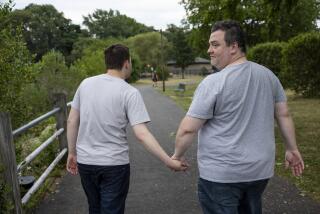UCLA Team Gets Results in Autism Treatment
- Share via
Nearly half of the autistic children participating in an intensive program begun 15 years ago now function normally, a record of success unprecedented in treatment of the disorder, scientists report.
Autism is a condition that usually appears in early childhood and is characterized by a failure to walk and talk, frequent delusions, hallucinations, violent behavior and a general withdrawal from reality.
Some children suffer spells of self-mutilation, aggressive behavior, emotional detachment and severe language deficiencies.
Hope for Schizophrenia
But behavioral scientists at UCLA now think that a special treatment they have developed may not only alleviate symptoms of the disorder permanently, but also may eventually prove effective in the treatment of childhood schizophrenia.
Dr. Ivar Lovass, reporting in the Journal of Consulting Clinical Psychology, said nine out of 19 children in his UCLA program were able to enter school and attend classes with normal children.
Eight others in the study attended special classes for children with language problems in public schools, and only two required placement in special classes for autistic children, he said.
“We used to treat these children in clinics and hospitals, but we found that the best place to work with them was in their homes, with their parents,” he said.
Self-Destructive Acts
During the first year, the program starts discouraging children from self-destructive and violent behavior. Since autistic children sometimes repeatedly bang their heads or other body parts on hard objects, parents are asked to pad edges and corners of furniture.
The second year focuses on helping them learn to talk and play with other children, and subsequent years emphasize the teaching of appropriate emotions as well as reading, writing and arithmetic.
“When you work with these children, you’re almost building a person from scratch. We had to put these kids together,” Lovass said.
“Normal children usually learn from morning to night--they’re learning machines. But because of the group of psychiatric disorders that occur in autism, such is not the case with these (autistic) children.”
Long Day’s Regimen
To increase the amount of time devoted to learning, Lovass developed a daylong program that was conducted by members of his research team and parents of the autistic children.
“When we left, the parents took over,” he said of a 16-hour daily regimen that incorporates the principles of behavior modification--reinforcement of acceptable behavior and punishment for undesirable actions.
“We’d give them a slap on the thigh or butt when they’d do something wrong,” Lovass said.
The nine children who attended regular school classes, and who Lovass said are completely recovered, are now between 10 and 20 years old and show no signs of permanent intellectual or behavioral impairment.
Lovass said placing these children in classes with other autistic children often is “the kiss of death.”
The psychologist noted that children who began his program by at least the age of 3 and who successfully completed kindergarten with normal children, also successfully completed the first grade and subsequent grades.
He said that he expects all of them to eventually have jobs and families.
More to Read
Sign up for Essential California
The most important California stories and recommendations in your inbox every morning.
You may occasionally receive promotional content from the Los Angeles Times.










